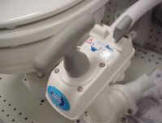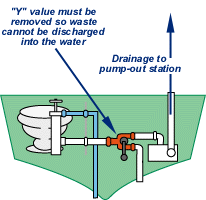Marine Sanitation Device - MSD
Preventing Pollution
 A Marine Sanitation Device (MSD) is designed to keep untreated
sewage out of the water. Every boat with an installed marine toilet
must have it connected to an operable Coast Guard approved MSD. Most
boats have one of three basic types of MSDs. (Type III MSDs are the
most common type found on boats.) A Marine Sanitation Device (MSD) is designed to keep untreated
sewage out of the water. Every boat with an installed marine toilet
must have it connected to an operable Coast Guard approved MSD. Most
boats have one of three basic types of MSDs. (Type III MSDs are the
most common type found on boats.)
Type I and II MSDs
These types macerate the sewage and then treat it with chemicals or
other means to reduce the bacterial count before it is discharged
overboard.
A Type I MSD must macerate the sewage to no visible solids, and then
reduce the bacteria count to less than 1,000 per 100 milliliters.
A Type II MSD macerates the sewage even finer so that the discharge
contains no suspended particles and the bacteria count must be below
200 per 100 milliliters.
Type III MSD
Type III MSDs are holding tanks. This is the most common type of MSD
found on boats. These systems are designed to retain or treat the
waste until it can be disposed of at the proper shoreside
facilities.
Portable toilets are the simplest type of MSDs. They represent the
easiest solution to marine sanitation on small boats because they
require minimal space, and are inexpensive, reliable and easy to
operate.
From the perspective of environmental impact, a Type III MSD -- when
used correctly -- may be best, because it conveys boat waste into a
local advanced sewage treatment system and reduces the need for
on-board use of potentially toxic tank treatment chemicals.
What's The Law?
It's illegal to discharge untreated sewage into any of California's
lakes, rivers, reservoirs, or coastal waters within the three-mile
U.S. territorial limit.
There are 11 federal 'No Discharge Areas' in California where it is
illegal to discharge any wastes, treated or untreated.
You are not required to have an installed marine toilet on your
boat, but if there is one, it must be connected to a Coast
Guard-approved MSD.
Boats 65 feet and under may use a Type I, II, or III MSD. Boats over
65 feet must have either a Type II or III MSD.
Certification: Make sure that your Type I or II MSD meets Coast
Guard requirements by looking for a certification label. A Type III
MSD is not required to have a label if it simply stores sewage at
ambient pressure and temperature.
The Coast Guard can issue fines of up to $2,000 for the illegal
discharge of sewage.
The Y Valve
 'Y' valves are used as part of some MSD systems to direct waste
overboard. If your sewage system is equipped with a Y valve for
overboard discharge, and you are operating on inland waters, in a
'No Discharge Area' (see back panel), or within the three-mile U.S.
territorial limit, you must secure the Y valve in the closed
position. The preferred method is to use a padlock or non-releasable
wire tie. If you have a thru-the-hull seacock, it must also be
secured. 'Y' valves are used as part of some MSD systems to direct waste
overboard. If your sewage system is equipped with a Y valve for
overboard discharge, and you are operating on inland waters, in a
'No Discharge Area' (see back panel), or within the three-mile U.S.
territorial limit, you must secure the Y valve in the closed
position. The preferred method is to use a padlock or non-releasable
wire tie. If you have a thru-the-hull seacock, it must also be
secured.
Additive Advice
The chemical disinfectants and deodorizers used in many MSDs can
contain chlorine, quaternary ammonia, or formaldehyde. All harmful
to aquatic life. When shopping for treatment products, read labels
carefully and take advantage of the many environmentally friendly
products now available without these ingredients. Be sure to follow
the directions for applying a sufficient amount of chemical to
ensure adequate treatment.
|

 A Marine Sanitation Device (MSD) is designed to keep untreated
sewage out of the water. Every boat with an installed marine toilet
must have it connected to an operable Coast Guard approved MSD. Most
boats have one of three basic types of MSDs. (Type III MSDs are the
most common type found on boats.)
A Marine Sanitation Device (MSD) is designed to keep untreated
sewage out of the water. Every boat with an installed marine toilet
must have it connected to an operable Coast Guard approved MSD. Most
boats have one of three basic types of MSDs. (Type III MSDs are the
most common type found on boats.) 'Y' valves are used as part of some MSD systems to direct waste
overboard. If your sewage system is equipped with a Y valve for
overboard discharge, and you are operating on inland waters, in a
'No Discharge Area' (see back panel), or within the three-mile U.S.
territorial limit, you must secure the Y valve in the closed
position. The preferred method is to use a padlock or non-releasable
wire tie. If you have a thru-the-hull seacock, it must also be
secured.
'Y' valves are used as part of some MSD systems to direct waste
overboard. If your sewage system is equipped with a Y valve for
overboard discharge, and you are operating on inland waters, in a
'No Discharge Area' (see back panel), or within the three-mile U.S.
territorial limit, you must secure the Y valve in the closed
position. The preferred method is to use a padlock or non-releasable
wire tie. If you have a thru-the-hull seacock, it must also be
secured.